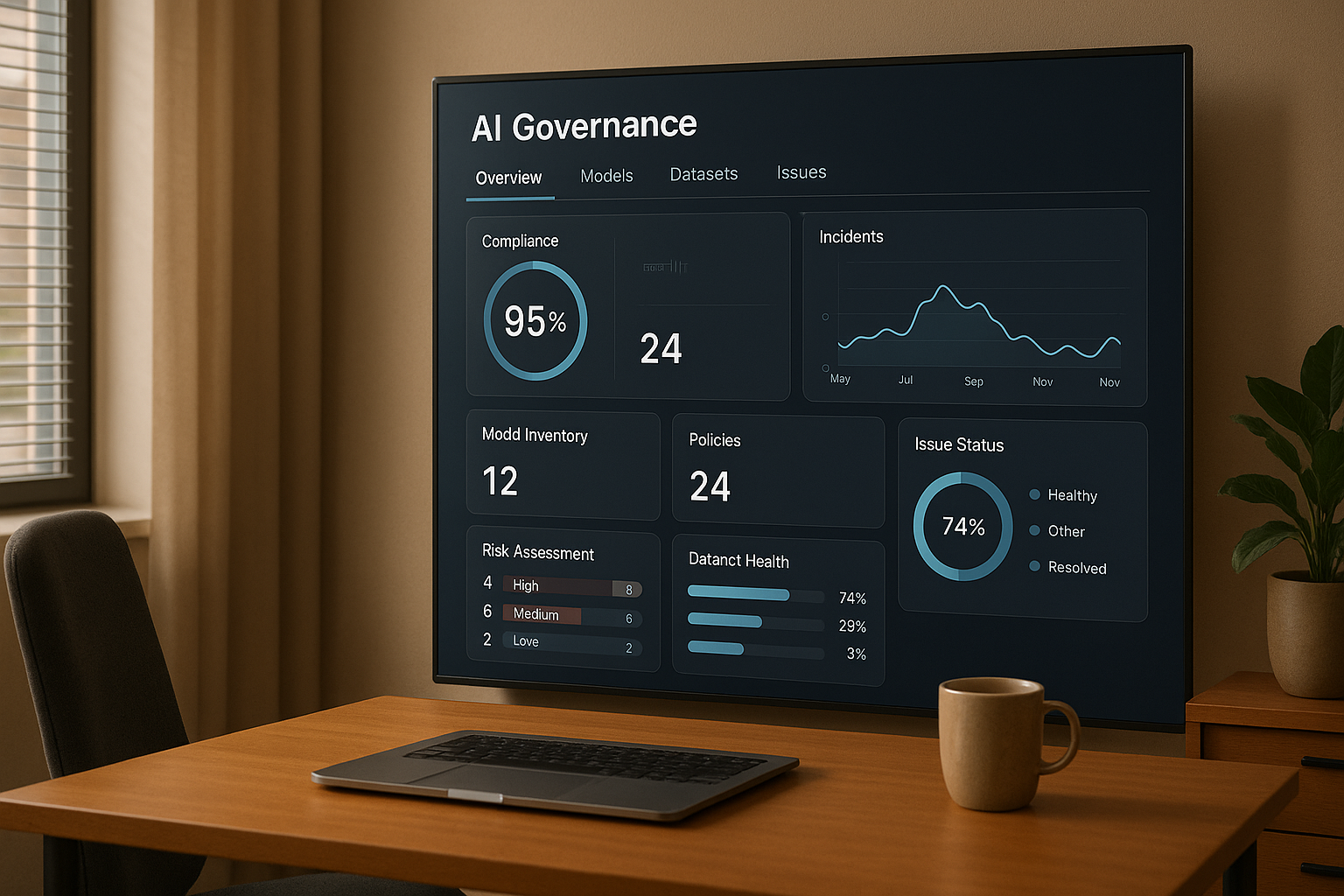
In today’s fast-paced AI landscape, managing compliance, risk, and costs without disrupting innovation is a top priority. This guide highlights five AI governance platforms tailored for U.S. businesses, each designed to simplify oversight, reduce risks, and optimize spending. Key features include real-time monitoring, automated compliance checks, and detailed audit trails. Whether you’re managing multiple AI models or focusing on a single provider, these platforms deliver governance solutions that align with U.S. regulatory standards and business needs.
| Platform | Key Strengths | Best For |
|---|---|---|
| Prompts.ai | Multi-model access, cost savings | Teams needing flexibility and cost control |
| IBM AI Governance | Bias detection, lifecycle management | Regulated industries |
| Azure OpenAI | Content safety, Azure integration | Enterprises using Microsoft tools |
| Google Cloud | Model monitoring, privacy tools | Scalable AI projects |
| SAS Viya | Lifecycle tracking, compliance | Businesses prioritizing governance |
Each platform excels in specific areas, helping businesses meet compliance requirements while maintaining efficiency. Explore the details below to find the right fit for your AI governance needs.
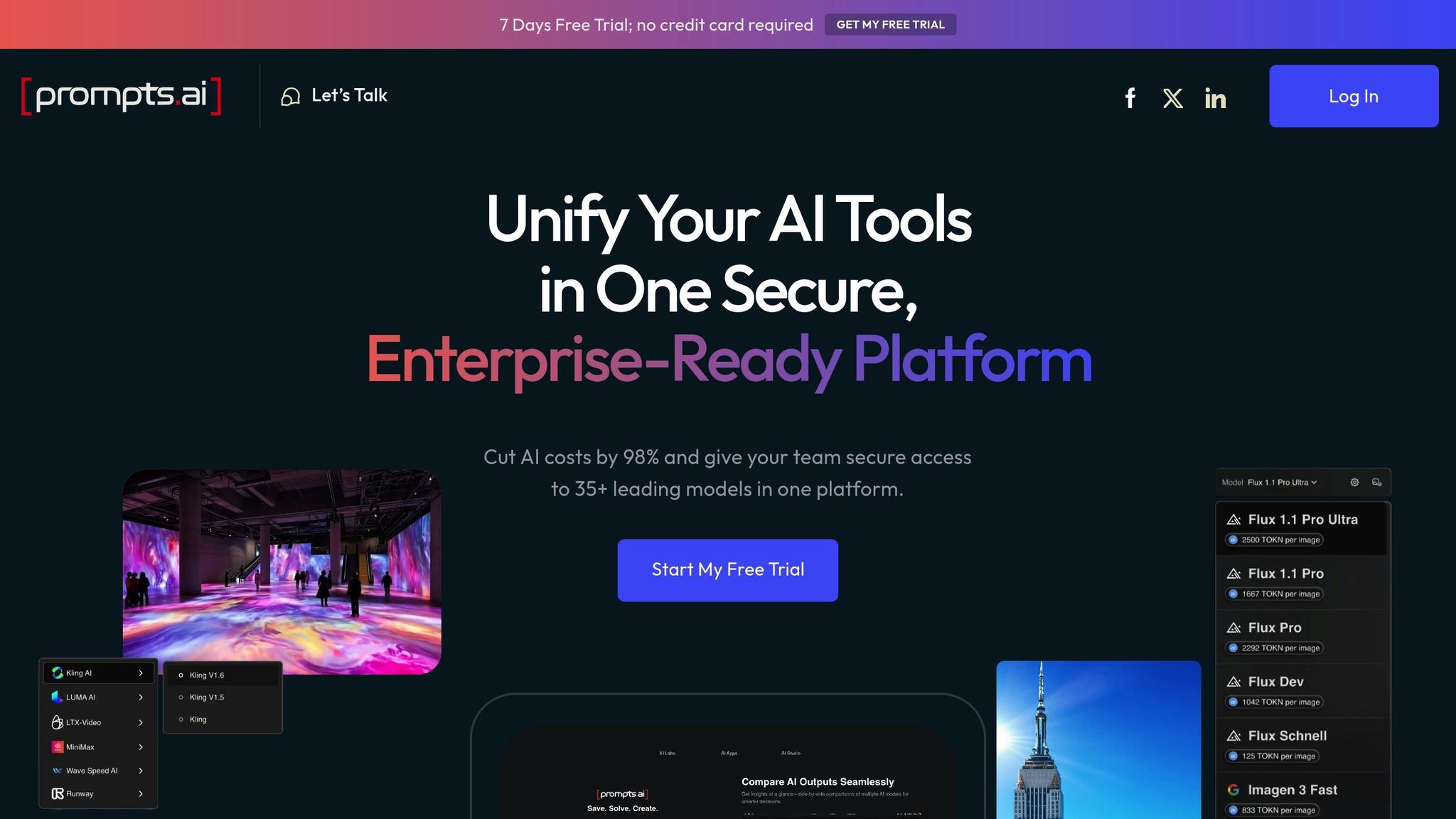
Prompts.ai is an enterprise AI orchestration platform designed to streamline access to over 35 top AI models - including GPT-4, Claude, LLaMA, and Gemini - through a single, secure interface. By consolidating these tools, it eliminates the complexity of managing multiple AI systems and simplifies governance processes.
Prompts.ai integrates governance controls directly into AI workflows, allowing teams to enforce policies, monitor usage, and stay compliant while taking full advantage of the platform’s AI capabilities.
Prompts.ai provides detailed audit trails that log prompt usage, model choices, and user actions, complete with MM/DD/YYYY timestamps. Its robust permission settings allow administrators to restrict access by user, team, or project, ensuring compliance with organizational policies. For companies with federal compliance needs, the platform’s environment isolation feature enables departments or projects to work in separate, secure AI environments while maintaining centralized oversight. These features collectively support cost management and regulatory adherence.
One of Prompts.ai’s standout governance tools is its real-time cost tracking. The platform monitors token usage at the prompt level and translates it into precise U.S. dollar costs, offering a clear breakdown of AI spending. As the platform highlights:
"Cut AI costs by 98% and give your team secure access to 35+ leading models in one platform."
Prompts.ai’s TOKN Pooling system further simplifies expense management by centralizing TOKN credits. For instance, the Creator plan, priced at $29/month, includes 250,000 TOKN credits for up to five workspaces, while the Problem Solver plan, at $99/month, offers 500,000 TOKN credits for unlimited workspaces. This approach converts unpredictable expenses into transparent, usage-based costs.
Prompts.ai incorporates advanced risk assessment features that operate without disrupting AI workflows. Its MCP Gateway monitors Model Context Protocol interactions in real time, offering insights into AI agent behavior. The platform’s Risk Scoring system evaluates the vulnerability of each MCP server, helping organizations prioritize security measures. Shadow MCP detection identifies unauthorized AI deployments, and its threat intelligence tools block malicious agents instantly. Administrators can enforce rules by managing actions based on user, server, or action type, ensuring governance policies are upheld automatically. These controls enhance security while maintaining operational efficiency.
Prompts.ai’s governance framework is designed to grow with an organization’s AI needs. The platform offers flexible pricing, starting with a Pay As You Go plan at $0/month, with options to upgrade as requirements expand. Annual plans include a 10% discount for long-term users. The unified interface consolidates various AI functions, reducing technical complexity and overhead. For larger teams, the Problem Solver plan supports up to 99 collaborators across unlimited workspaces, while workspace isolation ensures individual business units can operate independently under overarching governance policies. These features make Prompts.ai a reliable solution for U.S. enterprises aiming to balance efficiency with compliance.
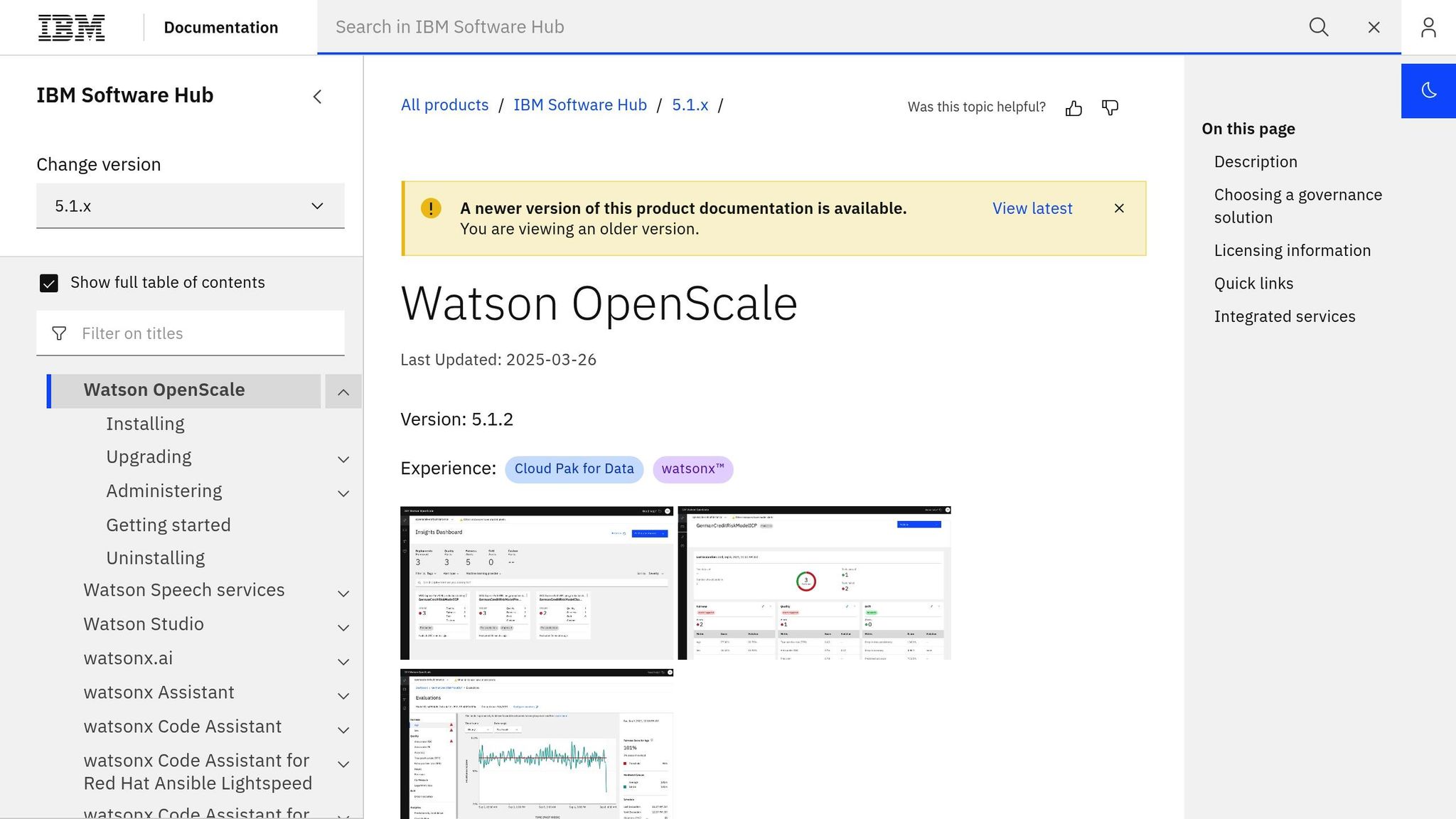
Watson OpenScale simplifies AI oversight for enterprises by automating monitoring and enforcing policies, particularly in challenging compliance environments. Built on IBM's reliable cloud infrastructure, it seamlessly integrates governance tools into existing workflows. This allows businesses to manage model lifecycles and adhere to regulations without interrupting development processes. Let’s explore some of its standout features.
Watson OpenScale uses AI FactSheets to automatically log critical details like training data, performance metrics, and decisions, complete with US-standard timestamps (MM/DD/YYYY). It also tracks data lineage from the moment it’s ingested to deployment, offering full transparency.
The platform comes equipped with templates for meeting regulations such as GDPR, CCPA, and healthcare-specific rules like HIPAA. It includes automated tools to detect bias and monitor ethical compliance, issuing alerts when models stray from preset guidelines. Additionally, it allows for separate audit logs tailored to different departments, ensuring centralized oversight without interfering with independent operations.
Watson OpenScale continuously evaluates AI performance in real time, keeping an eye on model drift, data quality, and performance dips using automated scoring systems. Its explainability tools offer insight into how decisions are made, making it easier to uncover biases or errors.
IBM's risk scoring mechanism accounts for variables like model complexity, data sensitivity, and regulatory demands. This weighted approach helps organizations prioritize governance efforts effectively across various AI deployments.
With its hybrid cloud architecture, Watson OpenScale adapts to both on-premises and cloud setups, ensuring consistent governance as businesses scale. Its compatibility with popular development tools and enterprise software - via APIs and pre-built connectors - makes it easy to gradually introduce or expand governance measures.
The platform also supports multi-cloud environments, enabling consistent oversight across different providers. IBM provides professional services to help businesses establish governance frameworks, and its modular design allows organizations to activate specific features as needed, with the flexibility to expand over time.
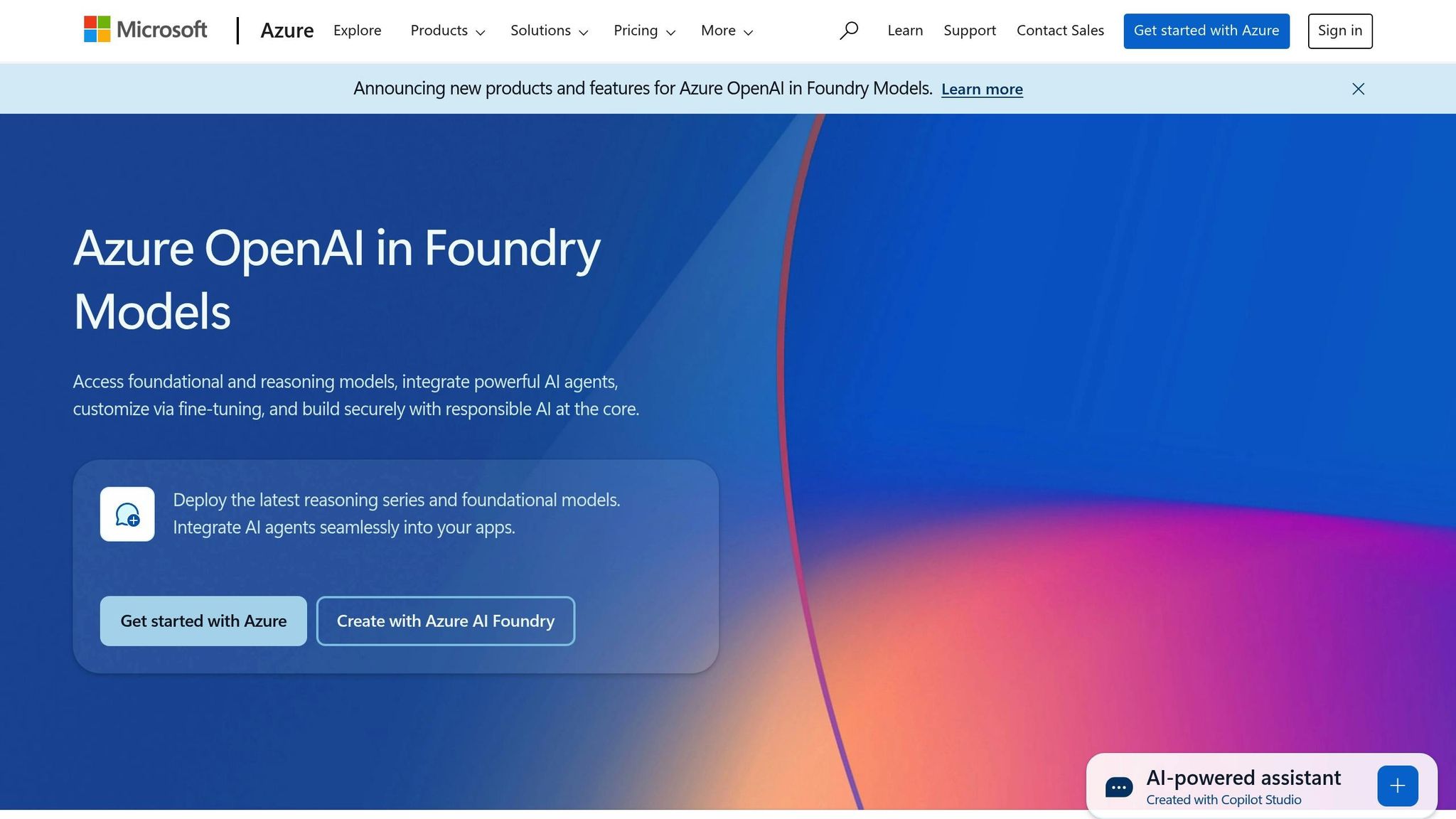
Microsoft's Azure OpenAI Service combines advanced AI models with essential governance tools, ensuring secure deployments that comply with regulatory and corporate standards. With Azure AI Content Safety and Responsible AI features integrated into the development process, teams can maintain strict oversight without slowing down innovation. The platform seamlessly incorporates compliance and cost management into its AI workflows, enabling organizations to deploy models like GPT-4 and GPT-3.5 while adhering to required standards.
Azure OpenAI Service automatically logs all API calls, capturing details such as user identities and timestamps (MM/DD/YYYY HH:MM:SS). The Content Safety Studio keeps a detailed record of content filtering decisions, documenting why specific prompts or outputs were flagged or blocked. This creates a reliable audit trail, demonstrating proactive risk management to both compliance officers and external auditors.
The platform also supports key compliance frameworks, including SOC 2, HIPAA, FedRAMP, and ISO 27001. Automated reporting tools generate documentation in formats required by U.S. regulatory bodies, simplifying the compliance process. Additionally, integration with Microsoft's Purview enhances governance by classifying and tracking sensitive data within AI workflows. This system automatically identifies personally identifiable information (PII) and enforces handling policies, ensuring consistent adherence to GDPR and CCPA requirements.
Azure OpenAI Service provides detailed cost visibility, allowing organizations to monitor spending by department, project, or user. Spending limits can be set at various levels, from individual API keys to entire resource groups, with automatic alerts triggered as usage nears predefined thresholds.
With Azure Budgets, organizations can implement automatic scaling controls. For example, high-cost operations can be throttled or redirected to more cost-effective models when monthly limits are reached. This ensures AI expenses remain predictable while maintaining availability for critical tasks. Real-time dashboards display token consumption patterns, helping teams optimize usage and assess the financial impact of their AI initiatives. These cost controls align with the platform's broader focus on proactive governance.
The platform continuously evaluates AI outputs using real-time risk scoring for categories such as hate speech, violence, self-harm, and inappropriate content. Configurable policies automatically block or flag problematic outputs, ensuring compliance with organizational and regulatory standards.
Prompt injection detection actively monitors for malicious inputs designed to manipulate AI behavior, logging incidents and applying immediate security measures. Risk scores are maintained for individual users and applications, helping administrators identify potential misuse or vulnerabilities.
Azure's Model Monitoring tracks performance trends and output quality over time, alerting teams when responses deviate from expected baselines. This ensures consistent governance, even as models are updated or usage patterns shift.
Azure OpenAI Service is designed to scale for enterprise workloads while maintaining robust governance across all deployments. Features like private endpoints and virtual network integration ensure that AI traffic remains within corporate networks, enhancing security.
Through Azure Active Directory, organizations can centralize identity management and apply existing role-based access controls to AI resources. This eliminates the need for separate governance systems, even as teams expand and new use cases arise. The platform's API Management layer enforces consistent policies across different AI services and versions.
Integration with Microsoft's Power Platform extends governance capabilities to citizen developers, offering pre-configured AI components with built-in safety features. This allows organizations to expand AI adoption while maintaining enterprise-grade oversight, ensuring growth without compromising governance standards.
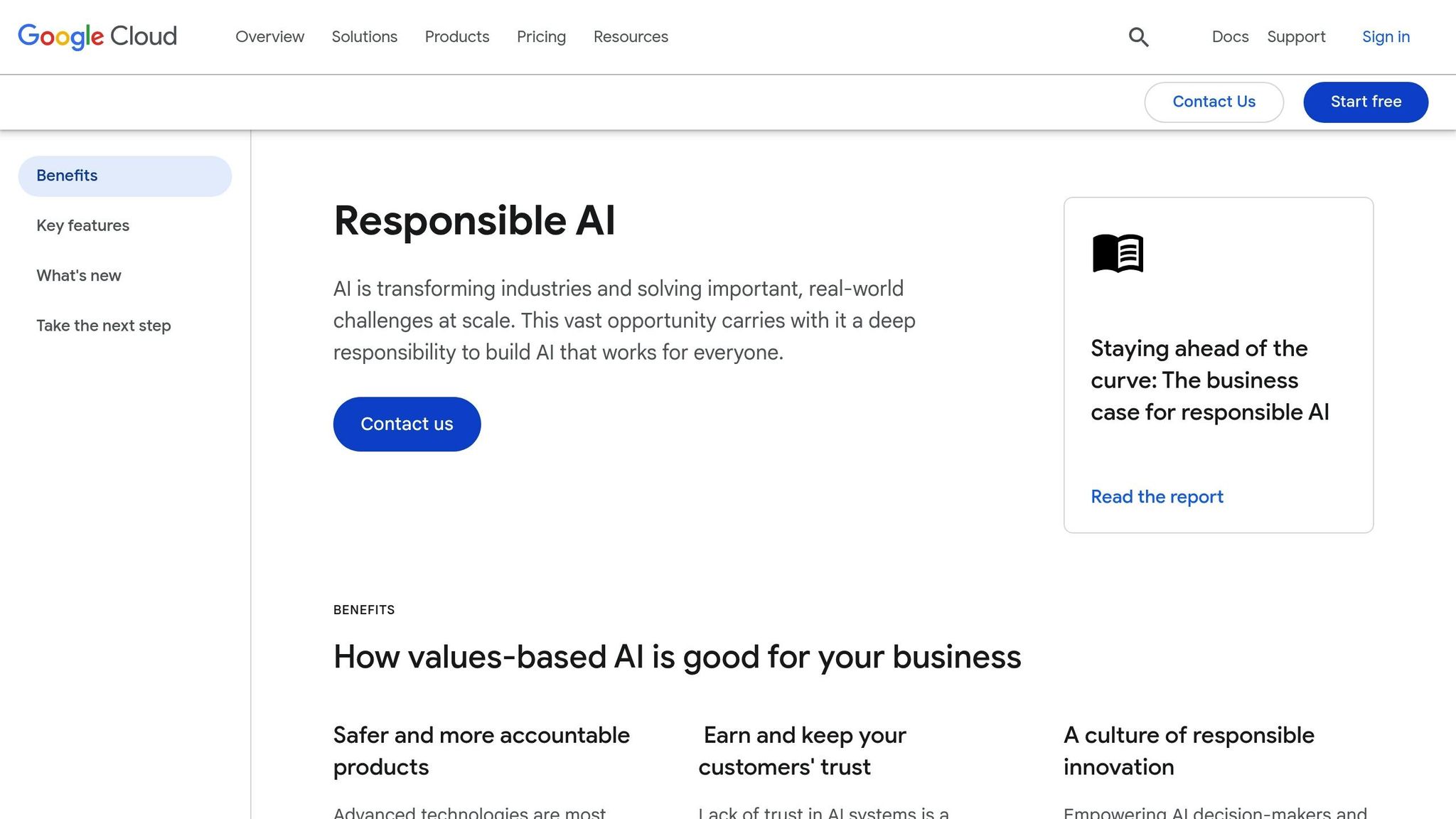
Google Cloud provides a suite of tools designed to give organizations centralized control over their AI operations. These tools help manage audit trails, compliance reporting, cost tracking, and risk evaluation. They also keep tabs on model version updates, enforce strict access controls, and monitor AI performance. This ensures businesses can meet both regulatory requirements and internal policies while maintaining a focus on advancing their AI capabilities. Google Cloud’s governance framework effectively supports the dual goals of compliance and scalable AI development.
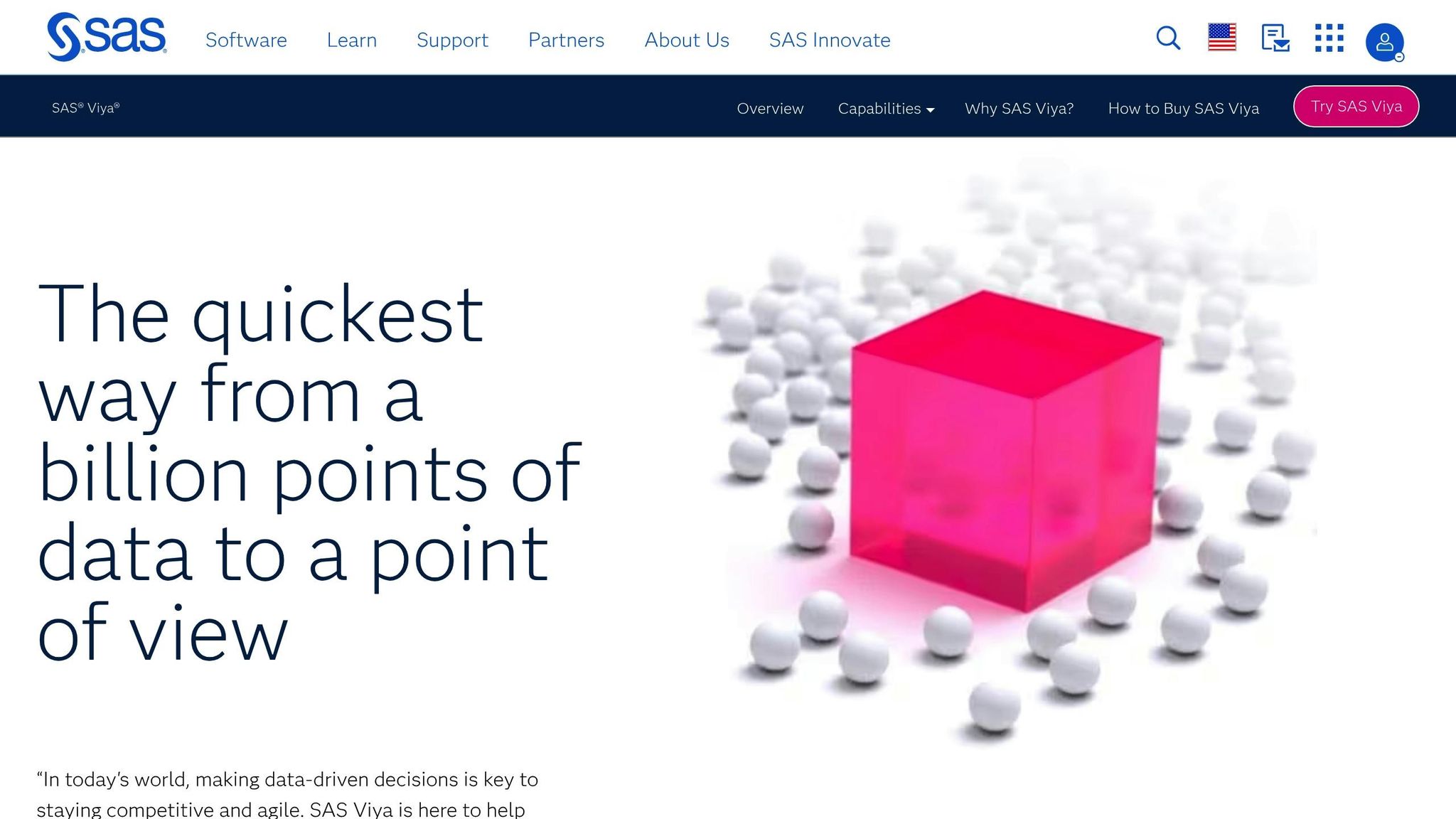
SAS Viya stands out by offering a comprehensive approach to managing AI models from their creation to deployment. With a strong emphasis on regulatory compliance, it delivers enterprise-level governance throughout the AI model lifecycle. Here's a closer look at how SAS Viya tackles key governance challenges.
SAS Viya meticulously tracks every stage of a model's lifecycle, capturing its lineage and documenting all changes made along the way. This includes automatic logging of model versions, data updates, and decision-making processes, ensuring a robust audit trail.
The platform simplifies regulatory compliance by generating detailed compliance reports tailored to frameworks like GDPR, CCPA, and financial services regulations. These reports provide insights into model performance, bias detection outcomes, and the rationale behind automated decisions. Organizations can further customize these templates to align with their specific regulatory needs.
To maintain high standards, SAS Viya employs a model validation framework that evaluates models for accuracy and fairness before they go live. If a model's performance deviates from acceptable thresholds, the system flags it for review, ensuring ongoing compliance with organizational and regulatory standards.
SAS Viya incorporates real-time monitoring tools to detect issues like bias and model drift. When models start producing results outside acceptable boundaries, the system triggers immediate alerts for corrective action.
The platform's explainability features provide clear, easy-to-understand insights into how AI models make decisions. This level of transparency empowers governance teams to assess whether the model's logic aligns with both ethical considerations and business goals.
SAS Viya is designed to operate seamlessly across both cloud and on-premises environments, offering consistent governance no matter the setup. Its ability to integrate with existing data warehouses, MLOps tools, and business intelligence systems means organizations can adopt it without overhauling their infrastructure.
The platform also facilitates collaboration, allowing data scientists, compliance teams, and stakeholders to work together on model approvals. Sensitive functions are safeguarded through role-based access controls, ensuring that only authorized personnel can access critical governance features.
Thanks to its API-driven architecture, SAS Viya can be embedded into existing development workflows. Teams can automate tasks like compliance checks, model validation, and audit report generation, all while integrating seamlessly with popular tools and CI/CD pipelines. This flexibility ensures that governance processes remain efficient and adaptable to evolving needs.
Below is a side-by-side look at the key features and benefits of each platform. For a deeper dive into each, refer to the detailed sections earlier in this guide.
| Platform Name | Key Features | Business Benefits |
|---|---|---|
| Prompts.ai | • Real-time FinOps with token-level cost tracking • Access to 35+ LLMs (GPT-4, Claude, LLaMA, Gemini) • Role-based permissions and audit logs • Isolated prompt environments • Flexible pay-as-you-go TOKN credits |
• Cut AI software costs by up to 98% • Simplify operations with a unified interface • Boost team efficiency • Deploy compliant workflows in minutes • Avoid recurring subscription fees |
| IBM AI Governance | • Full model lifecycle management • Automated bias detection and monitoring • Enterprise-level security controls • Watson ecosystem integration • Built-in regulatory frameworks |
• Lower compliance-related expenses • Reduce regulatory risks • Streamline model deployment • Maximize existing IBM infrastructure • Extend governance across the organization |
| Microsoft Azure OpenAI Service | • Integrated content filtering and safety tools • Azure ecosystem compatibility • Responsible AI dashboard • Customizable policy enforcement • Enterprise-grade security |
• Seamless integration with Microsoft 365 • Leverage existing Azure investments • Speed up deployment timelines • Maintain a familiar user experience • Ensure enterprise-level reliability |
| Google Cloud AI Governance | • Ongoing model monitoring and drift detection • Explainable AI functionality • Integration with Vertex AI • Automated ML pipeline governance • Privacy-focused analytics |
• Accelerate ML model rollouts • Simplify operational workflows • Enhance model transparency • Scale AI projects effectively • Utilize Google’s AI expertise |
| SAS Viya AI Governance | • Comprehensive model lifecycle tracking • Regulatory compliance reporting • Real-time bias and drift monitoring • Support for cross-environment deployments • API-driven automation |
• Ensure compliance with regulations • Shorten model validation timelines • Enable collaborative workflows • Integrate with existing systems • Automate governance tasks |
This table showcases the diverse approaches to AI governance. Prompts.ai is ideal for businesses focused on cost control and multi-model flexibility, offering significant savings while maintaining enterprise-level governance. Platforms like IBM and SAS Viya are particularly suited for industries with strict regulatory requirements due to their robust compliance tools.
Organizations already invested in the Microsoft ecosystem will find Azure OpenAI Service to be the most seamless option, while Google Cloud AI Governance excels in automating ML pipeline management. Ultimately, the best choice depends on your current infrastructure, regulatory needs, and whether you require governance across multiple AI models or prefer sticking to a single provider.
For businesses seeking adaptability and avoiding vendor lock-in, platforms supporting multiple LLM providers offer the greatest strategic flexibility. This ensures your governance framework stays relevant as new models and technologies emerge, minimizing the risks and costs of future migrations. These insights align with the governance strengths detailed earlier in this guide.
The platforms we reviewed demonstrate how effective AI governance is transforming the way organizations in the US manage AI. By ensuring operations remain controlled and compliant, businesses can tackle regulatory challenges and manage the high costs associated with AI deployment. The real challenge lies in balancing immediate operational gains with the need for long-term adaptability.
Among the platforms analyzed, one stands out: Prompts.ai. It slashes AI software costs by up to 98% while providing access to over 35 leading models. Features like real-time token tracking, robust permission controls, and isolated prompt environments offer the transparency and security compliance teams require. These specific advantages align closely with the principles we’ve discussed, making it a compelling choice for organizations aiming to streamline their AI strategies.
Prompts.ai makes navigating U.S. compliance regulations straightforward by providing tools to oversee and control AI usage with ease. It enables businesses to pinpoint and monitor sensitive data, apply governance policies, and create automated reports that adhere to essential legal frameworks like HIPAA and GDPR.
Key features such as audit trails, permission controls, and policy enforcement promote ethical and transparent AI practices. These tools are tailored to align with federal requirements and adapt to changing regulatory standards, empowering businesses to confidently manage multiple AI models while remaining compliant.
Prompts.ai delivers impactful tools to help businesses manage AI costs efficiently. With features like dynamic prompt routing, real-time token tracking, and a flexible pay-per-use model driven by TOKN credits, companies can reduce AI-related expenses by as much as 98%.
These features are designed to cut down on excessive model calls, boost token efficiency, and align spending with actual usage. By simplifying operations and providing precise cost management, Prompts.ai empowers businesses to stay within budget while supporting scalable and responsible AI solutions.
Prompts.ai simplifies risk assessment and monitoring by combining real-time cost tracking, advanced routing, and fallback strategies. These features operate together to provide uninterrupted oversight, keeping AI workflows efficient and running smoothly.
The platform also incorporates compliance tools and strong monitoring systems, enabling businesses to stay accountable and align with ethical standards on a larger scale. This balance ensures effective governance without sacrificing productivity or performance.


